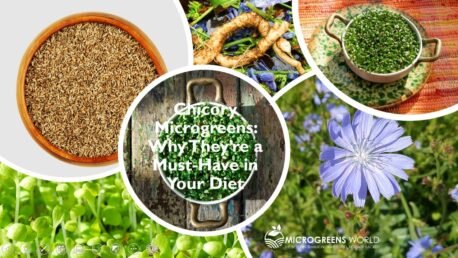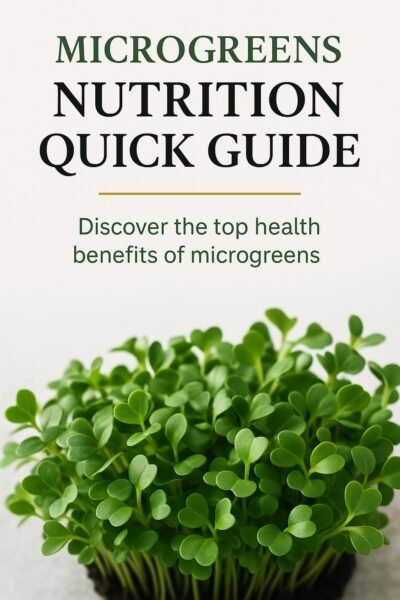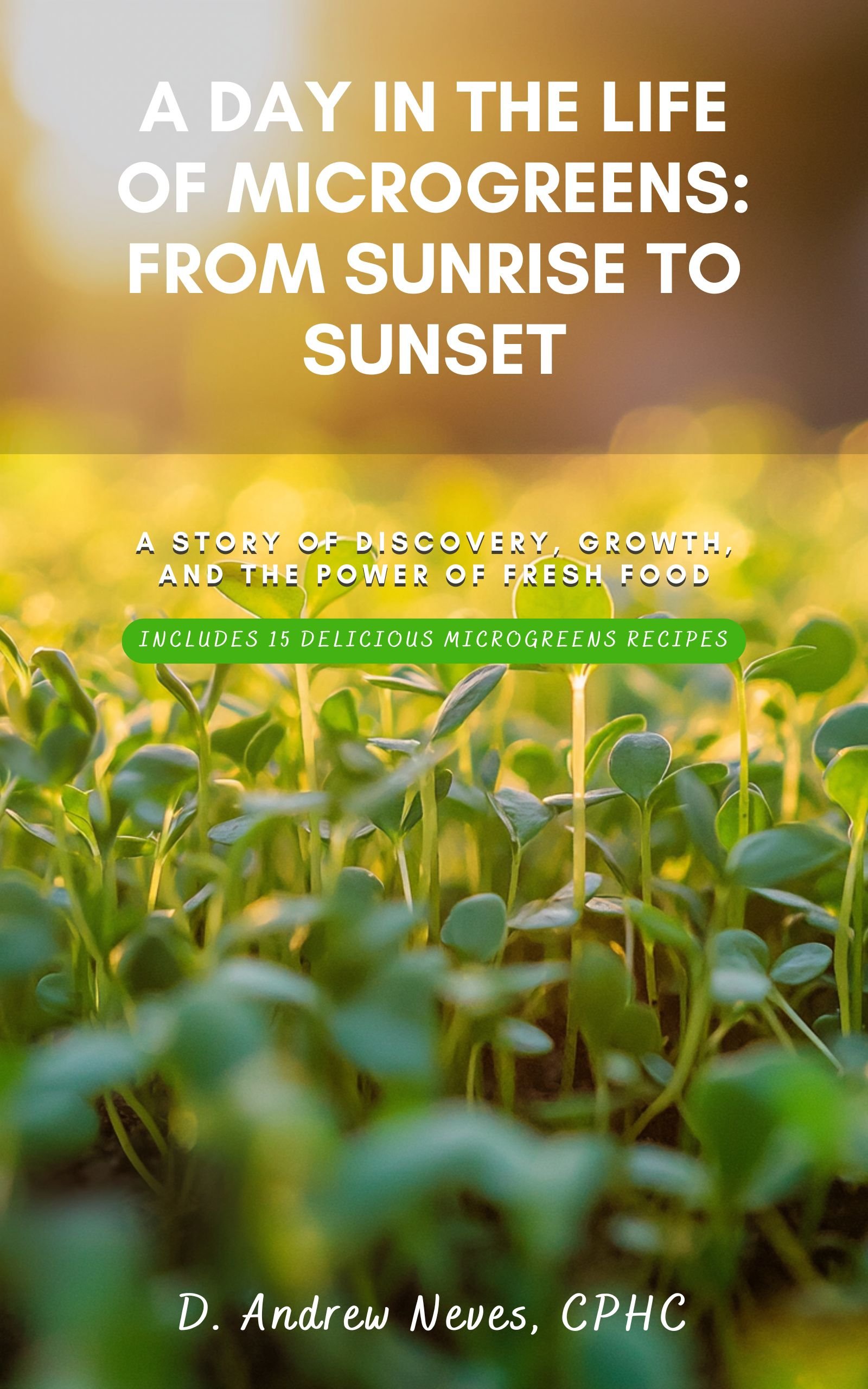When Alex, my friend, visited me last weekend, he brought me a packet of chia seeds. I was thankful as it’d been months since I bought chia seeds; I had switched to chia microgreens. Alex was surprised as he had never tasted these amazing microgreens. I took it upon myself to educate him on chia microgreens.
Chia microgreens are nutrient-packed, containing all 18 amino acids, 23.7g of omega-3 fatty acids, vitamins thiamin (B1), niacin (B3), and more than 100% daily fiber. It is a mineral storehouse containing calcium (48.5%), iron (42.9%), magnesium (79.8%), phosphorus (68.8%), zinc(41.6%), and more than 100% of the daily recommended value of copper (102.7%), manganese (118.3%), and selenium (100.4%).[1]
This post will explore how these tiny wonders can elevate nutrition and health. Discover the fascinating importance of chia microgreens, uncover their remarkable nutritional profile, and explore practical ways to incorporate them into your daily life.
Get ready to embark on a journey of wellness and vitality as we delve into the world of chia microgreens.
Key Takeaways
- Chia microgreens contain all 18 amino acids and 23.7g of omega-3 fatty acids, exceeding 100% daily fiber requirements.
- Exceptional mineral content includes calcium (48.5%), iron (42.9%), magnesium (79.8%), phosphorus (68.8%), and zinc (41.6%)
- Provides over 100% RDI of copper (102.7%), manganese (118.3%), and selenium (100.4%) for optimal body function
- Contains B-complex vitamins, including thiamin (B1) at 51.7% and niacin (B3) at 55.2%, supporting energy production
- Low-carbohydrate content makes them ideal for low-carb diets, offering superior immunity, energy, and digestive benefits
INTERESTED IN MICROGREENS?
Join the community
Join more than 50,000 other health-conscious individuals and couples who visit our site and receive weekly emails from us to help them grow more microgreens to live healthier and longer lives.

Unveiling the Tiny Powerhouse: Chia Microgreens
Chia is a flowering plant of the mint family Lamiaceae, known scientifically as Salvia hispanica. Originating from Central and Southern Mexico and Guatemala, chia has been cultivated for centuries, dating back to the Aztecs and Mayans.[2] These civilizations recognized chia as a staple food crop and utilized it for its energy-boosting properties.[3]
Scientific Name: Salvia hispanica
Common Name: Chia
Plant Family: Mint family, Lamiaceae
Etymology: “Chia” is derived from the Nahuatl word “chian,” meaning ‘oily.’ One of two plants known as chia is salva hispanica, the second being salva columbariae, sometimes called “golden chia.” The species was named hispanica (“of Spain”) because Linnaeus described the species from cultivated plants in Spain.
The Aztecs, in particular, held chia seeds in high regard and considered them a staple food. Chia seeds were a crucial component of the Aztec diet due to their exceptional nutritional value and ability to provide sustained energy. Warriors and runners would consume chia seeds to fuel their physical activities, earning the seeds the reputation of being a “superfood” of that era.
Fast forward to today, chia seeds have gained global recognition as a “superfood” due to their impressive nutritional profile. However, the spotlight is shifting towards chia microgreens, the young sprouts of chia seeds packed with even more nutritional benefits.
Like their mature counterparts, chia microgreens are rich in omega-3 fatty acids, fiber, protein, vitamins, and minerals. However, these microgreens are even more nutrient-dense, making them an excellent addition to any diet.
Beyond their nutritional prowess, chia microgreens also offer unique flavor profiles. They exhibit a mild, nutty taste with hints of fresh greens, making them a versatile addition to various dishes and recipes. The vast culinary possibilities allow you to unleash your creativity in the kitchen while boosting the nutritional value of your meals.
The other variety of chia is Salvia columbariae, commonly known as chia, chia sage, golden chia, or desert chia, is an annual plant that grows in California, Nevada, Utah, Arizona, New Mexico, Sonora, and Baja California. Its seeds are used the same way as Salvia hispanica (chia) and were a vital food for Native Americans.
Chia microgreens are the chia plant’s young shoots and are usually harvested between 6 to 12 days.
Chia microgreens are a powerhouse of nutrition, offering many health benefits in a tiny, easy-to-grow package. Whether you’re a home gardener or a commercial grower, chia microgreens are a worthy addition to your planting roster.
There are hundreds of plants, herbs, roots, and fruits you can grow and eat as microgreens. Explore my post “Top 30 Microgreens You Can Easily Grow Indoors.”
| Name | Amount | Daily Value | %Daily Value |
|---|---|---|---|
| Water | 5.8 g | ||
| Energy | 486 kcal | ||
| Energy | 2030 kJ | ||
| Protein | 16.5 g | 50 g | 33.0% |
| Total lipid (fat) | 30.7 g | 78 g | 39.4% |
| Ash | 4.8 g | ||
| Carbohydrate, by difference | 42.1 g | 275 g | 15.3% |
| Fiber, total dietary | 34.4 g | 28 g | 122.9% |
| Calcium, Ca | 631 mg | 1300 mg | 48.5% |
| Iron, Fe | 7.72 mg | 18 mg | 42.9% |
| Magnesium, Mg | 335 mg | 420 mg | 79.8% |
| Phosphorus, P | 860 mg | 1250 mg | 68.8% |
| Potassium, K | 407 mg | 4700 mg | 8.7% |
| Sodium, Na | 16 mg | 2300 mg | 0.7% |
| Zinc, Zn | 4.58 mg | 11 mg | 41.6% |
| Copper, Cu | 0.924 mg | 0.9 mg | 102.7% |
| Manganese, Mn | 2.72 mg | 2.3 mg | 118.3% |
| Selenium, Se | 55.2 µg | 55 mcg | 100.4% |
| Vitamin C, total ascorbic acid | 1.6 mg | 90 mg | 1.8% |
| Thiamin | 0.62 mg | 1.2 mg | 51.7% |
| Riboflavin | 0.17 mg | 1.3 mg | 13.1% |
| Niacin | 8.83 mg | 16 mg | 55.2% |
| Folate, total | 49 µg | 400 mcg | 12.3% |
| Vitamin A, IU | 54 IU | ||
| Vitamin E (alpha-tocopherol) | 0.5 mg | 15 mg | 3.3% |
| Fatty acids, total saturated | 3.33 g | ||
| Fatty acids, total monounsaturated | 2.31 g | ||
| Fatty acids, total polyunsaturated | 23.7 g | ||
| Fatty acids, total trans | 0.14 g | ||
| Tryptophan | 0.436 g | ||
| Threonine | 0.709 g | ||
| Isoleucine | 0.801 g | ||
| Leucine | 1.37 g | ||
| Lysine | 0.97 g | ||
| Methionine | 0.588 g | ||
| Cystine | 0.407 g | ||
| Phenylalanine | 1.02 g | ||
| Tyrosine | 0.563 g | ||
| Valine | 0.95 g | ||
| Arginine | 2.14 g | ||
| Histidine | 0.531 g | ||
| Alanine | 1.04 g | ||
| Aspartic acid | 1.69 g | ||
| Glutamic acid | 3.5 g | ||
| Glycine | 0.943 g | ||
| Proline | 0.776 g | ||
| Serine | 1.05 g |
Table: Chia microgreens nutrition facts
Chia Microgreens: Nutritional Analysis
Chia microgreens may offer some benefits not found in chia seeds. Since chia microgreens contain low amounts of carbohydrates, they are preferable for people following low-carb diets. More vitamins and enzymes are also in chia microgreens, which may offer additional health advantages like higher immunity, more energy, and better digestion.
The 34.4g of fiber in chia microgreens is 122.9% of the daily required amount making these tiny microgreens a premier source of fiber.
Protein helps in the development and repair of tissues. Chia microgreens contain 16.5g of protein, representing 33% of the required daily value.
Amino Acids
Amino acids, which can be mixed with 20 different kinds of alanines to create proteins, are protein building blocks. The microgreen Chia contains eighteen of the 20 amino acids. There are 11 amino acids in the human body, but the other nine must be obtained from food. The nine amino acids are known as essential amino acids. A complete protein is a food containing at least nine Essential Amino Acids in adequate quantities.
Along with quinoa, buckwheat, amaranth, and hemp, chia microgreens are a complete protein.
Vitamins
Thiamine (0.62mg, 51.7%), vitamin B1, is a water-soluble vitamin crucial in converting food into energy. It is essential for adequately functioning the heart, muscles, and nervous system.
Niacin (8.83mg, 55.2%), vitamin B3, is a water-soluble vitamin crucial in converting food into energy. It is essential for the proper functioning of the nervous system, digestive system, and skin.
Explore more about the U.S. Recommended Dietary Allowance (RDA) necessary to meet your nutritional requirements in my post, “Eat To Meet Your RDA: The 12 Microgreens Vitamins You Need.”
Minerals
Minerals play a crucial role in human energy generation and output. They are involved in many processes that help convert food into energy, including the metabolism of carbohydrates, fats, and proteins.
Some minerals, such as magnesium, are essential for producing Adenosine triphosphate (ATP), the universal energy source of all living cells. Iron is needed for oxygen to be transported in cells, which is essential for producing electricity. Other minerals, such as calcium and potassium, are essential for muscle contraction and nerve function, which are necessary for physical activity.
Aztec warriors and runners would consume chia seeds to fuel their physical activities, earning the seeds the reputation of being a “superfood” of that era.
One handful of chia microgreens provides you with nearly one-half of your calcium (48.5%) and iron (42.9%), four-fifths of your magnesium (78.9%), two-thirds of phosphorous, two-fifths of your zinc (41.6%), and more than 100% of your copper (102.7%), manganese (118,3%), and selenium (100.4%) daily needs.
Impressive!
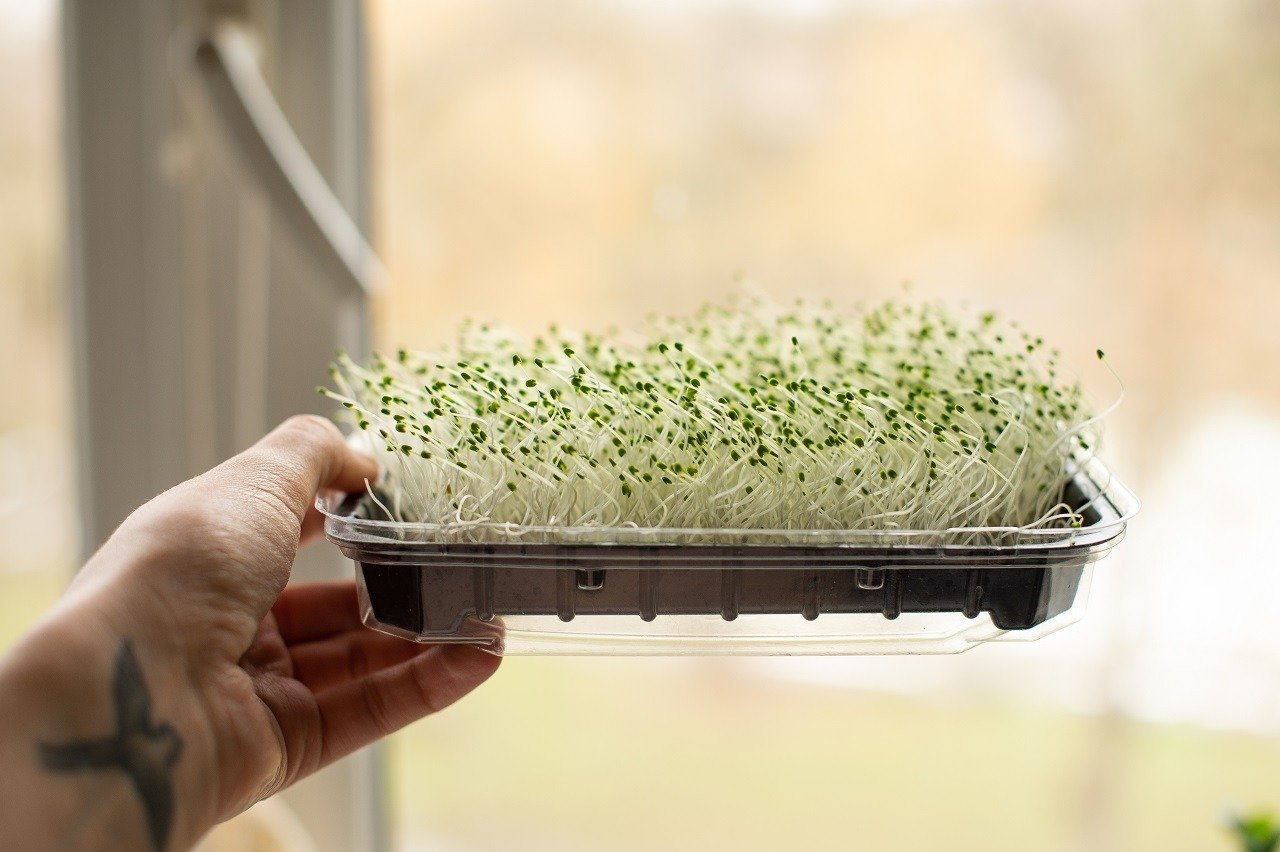
Health Benefits of Chia Microgreens
Chia microgreens are a nutrient-rich food, which is vital to the health of your diet. Below are some notable health benefits of chia microgreens:
Energy Production: With their high content of B vitamins and minerals like magnesium and iron, chia microgreens support energy production at a cellular level, helping to keep you energized and alert. [6]
Muscle and Tissue Repair: As a complete protein source, chia microgreens provide all the essential amino acids needed for muscle and tissue repair, making them an excellent addition to post-workout meals.
Supporting Brain and Heart Health: One of the standout features of chia microgreens is their impressive omega-3 fatty acid content. Omega-3 fatty acids, particularly alpha-linolenic acid (ALA), provide numerous health benefits. These essential fats support brain function, cognitive performance, and mental well-being. Incorporating chia microgreens into your diet can enhance focus, memory, and overall brain health. [5]
Thiamine deficiency can lead to beriberi, which can cause symptoms such as weakness, fatigue, nerve damage, and heart failure. Niacin deficiency can lead to pellagra, which can cause symptoms such as dermatitis, diarrhea, and dementia.
Supports Digestive Health: Chia microgreens are an excellent dietary fiber source supporting a healthy digestive system. Fiber aids digestion, prevents constipation, and supports the growth of beneficial gut bacteria. Consuming chia microgreens can help maintain regular bowel movements and support overall digestive health. [6]
Potential Anti-Inflammatory Effects: Chia microgreens contain compounds with potential anti-inflammatory properties, such as chlorophyll and flavonols. By reducing inflammation, chia microgreens may help alleviate symptoms of chronic inflammatory conditions and promote overall wellness. [7]
Healthy Weight Management: Chia microgreens are low in calories and fiber, making them essential in weight management. The fiber content helps increase satiety, reducing the likelihood of overeating. Additionally, the combination of nutrients in chia microgreens supports overall metabolic health. [8]
Chia microgreens are a nutritional powerhouse that can contribute to overall health and well-being in numerous ways.
Please note that while chia microgreens have many potential health benefits, it’s essential to consume them as part of a balanced diet and not rely on them as the sole treatment for any medical conditions. Always consult with your primary healthcare professional before making any changes in your diet.
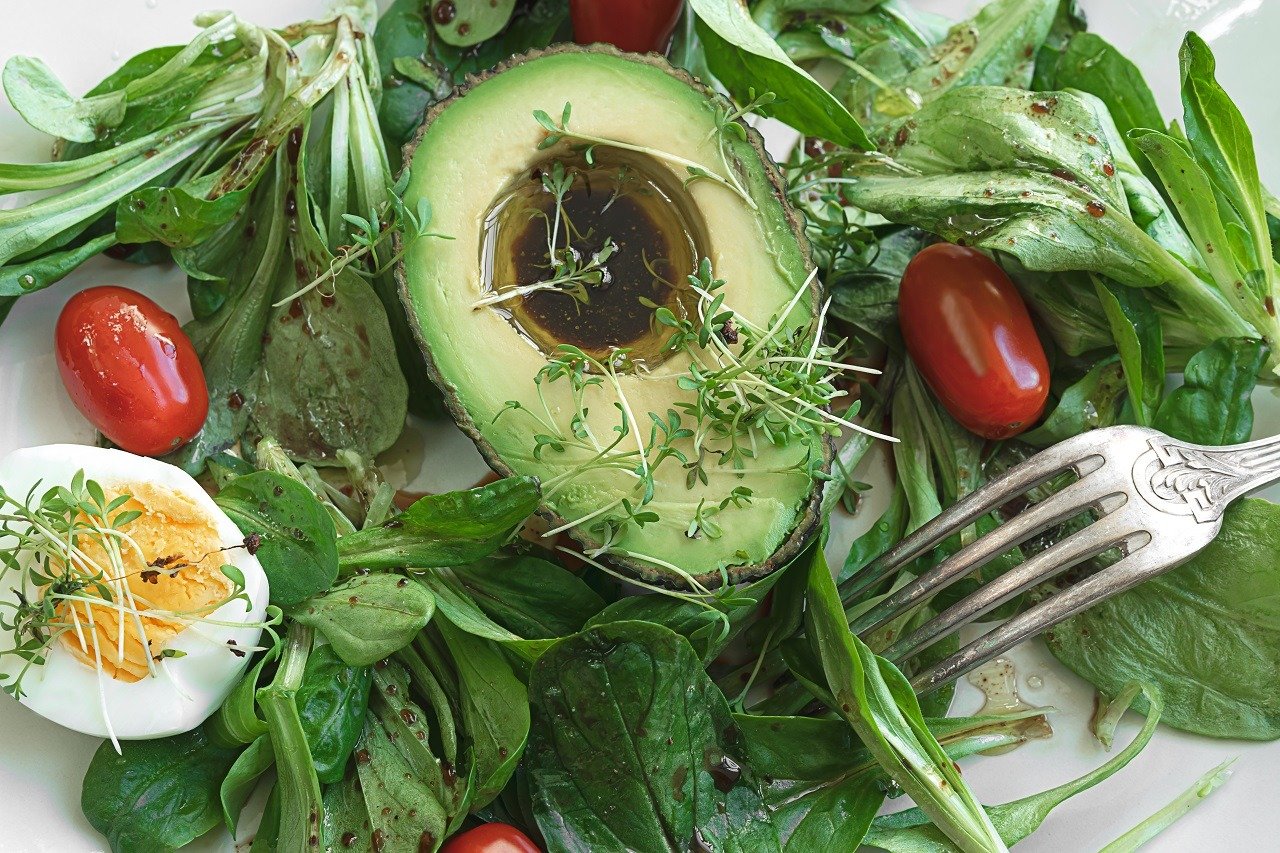
Culinary Delights with Chia Microgreens
Now that you understand the remarkable benefits of chia microgreens, it’s time to explore practical ways to incorporate them into your daily routine.
Chia microgreens have a mild, slightly nutty flavor with a hint of freshness. Their taste is not as pronounced as some other microgreens, making them a versatile addition to a variety of dishes. The texture of chia microgreens is a bit crunchy when fresh, adding a nice contrast to softer foods. They are perfect for adding a subtle, healthy boost to salads, sandwiches, smoothies, and more without overpowering other flavors.
Here are a few simple tips to make the most of these nutrition powerhouses:
Salad Sensation
Add a generous handful of chia microgreens to your salads for an extra burst of flavor and nutrition. Their vibrant green color will enhance the visual appeal of your dish, while their delicate texture adds a delightful crunch.
Juice and Smoothie Boost
Amp up the nutritional value of your morning smoothies by blending a handful of chia microgreens into the mix. Combine them with your favorite fruits, yogurt, and a liquid for a refreshing and nutrient-packed beverage.
Garnish with Greens
Sprinkle chia microgreens over soups, stir-fries, or roasted vegetables to elevate the visual appeal and introduce a pop of freshness. Their mild flavor complements a wide range of dishes, enhancing taste and nutrition.
Check out this delicious recipe, “Peanut Butter-Banana Chia Seed Toast.“
Want more ideas on using radish and other microgreens in your daily meals? Read my post, “Mastering the Art – How Chefs Pair Microgreens with Proteins for a Nutritional Boost.“
Growing Chia Microgreens: Special Conditions
Like their seed counterparts, chia microgreens have a few unique growing conditions that set them apart from other microgreens.
Seed Sourcing
Chia seeds are tiny and have a hard shell, making them more challenging to source. Finding high-quality, organic seeds from a reputable supplier is essential to ensure optimal germination and growth.
Planting
Chia seeds do not need to be covered as they require light to germinate.
Growing
Chia microgreens prefer a warm, well-lit environment. They proliferate and can reach harvest size in just 8-12 days.
Packaging
Due to their delicate nature, chia microgreens are best packaged in breathable containers that allow for some airflow to prevent moisture buildup and prolong shelf life.
Chia microgreens require a little more careful handling and specific growing conditions, but their nutritional payoff makes the effort worthwhile.
Explore sustainable microgreens farming in my post, “The Complete Guide to Organic Microgreens Farming: For Home Gardeners and Entrepreneurs.”
Wrap-up: Chia Microgreens Nutrition
In exploring chia microgreens, we’ve delved into their rich history, nutritional profile, and unique growing conditions. Here are the key points to remember:
Like their seed counterparts, Chia microgreens have a rich history dating back to the Aztecs, who valued them for their energy-boosting properties. It’s a whole protein that contains all nine essential amino acids. They are also packed with fiber, vitamins, and minerals, making them a nutrient-dense addition to any diet.
The potent nutrients in chia microgreens contribute to various health benefits, including improved digestion, enhanced energy levels, and boosted immunity.
Chia microgreens offer a mild, nutty flavor that complements a variety of dishes, from salads to smoothies.
Chia microgreens have specific growing conditions that require careful handling, from seed sourcing to harvesting. However, their rapid growth cycle and minimal space requirements make them an excellent choice for home gardeners and urban dwellers.
We encourage you to incorporate chia microgreens into your diet and experience their remarkable health benefits firsthand. Whether you grow them at home or purchase them from a local farmer’s market, these tiny greens pack a nutritional punch that’s hard to beat.
Embrace the ancient wisdom of chia seeds and elevate your well-being with the remarkable power of chia microgreens.
Related Questions
How do chia microgreens taste?
Chia microgreens have a unique and delicate flavor profile often described as mild, slightly nutty, and reminiscent of fresh greens. Their taste can vary slightly depending on growing conditions and maturity.
Explore more about the taste of microgreens in my post, “What Do Microgreens Taste Like?”
Are chia microgreens suitable for individuals with dietary restrictions?
Yes, chia microgreens are suitable for various dietary needs. They are naturally gluten-free and very low in sugar, making them an excellent choice for individuals with gluten sensitivities or celiac disease.
Are chia microgreens safe to eat?
Answer: Yes, chia microgreens are safe to eat. They are a good source of nutrients and antioxidants and have a mild flavor, making them a versatile ingredient. It must be borne in mind that chia microgreens can produce high levels of oxalates, which can adversely affect patients with kidney disease. If you have kidney disease, avoiding chia microgreens or consuming them in moderation is best.
Discover food safety and microgreens in my post, “Can Microgreens Make You Sick?”
If you want more in-depth information, contact Andrew Neves at andrew.neves@microgreensworld.com.
Share The Guide
Ready to embrace the nutritional power of chia microgreens? Start incorporating these vibrant greens into your daily meals and experience the transformative benefits firsthand.
Share your favorite chia microgreen recipes, tips, and thoughts. Join the community of wellness enthusiasts on this nourishing journey.
Thank you for reading!
Together, we can help more people learn about the health benefits of chia microgreens and start incorporating them into their diets.
- For a wealth of knowledge, read the post “The Beginner’s Nutritional Guide to Incredible Microgreens” to explore more about microgreens.
- Discover how to grow microgreens. Read this post, “Beyond the Windowsill: Growing Microgreens on Your Balcony or Patio.“
- Interested in the business side? “Harnessing Technology for a Greener Future: A Guide for Microgreens Entrepreneurs.”
INTERESTED IN MICROGREENS?
Join the community
Join more than 50,000 other health-conscious individuals and couples who visit our site and receive weekly emails from us to help them grow more microgreens to live healthier and longer lives.
References
- Rdn, A. B. M. (2023, May 11). Chia Seeds 101: Nutrition Facts and Health Benefits. Healthline. https://www.healthline.com/nutrition/chia-seeds#vitamins-minerals
- Ullah R, Nadeem M, Khalique A, Imran M, Mehmood S, Javid A, Hussain J. Nutritional and therapeutic perspectives of Chia (Salvia hispanica L.): a review. J Food Sci Technol. 2016 Apr;53(4):1750-8. doi:10.1007/s13197-015-1967-0. Epub 2015 Oct 1. PMID: 27413203; PMCID: PMC4926888.
- Armstrong D (2004) Application for approval of whole chia (Salvia hispanica L.) seed and ground whole seed as a novel food ingredient. Northern Ireland, R.
- FoodData Central. (n.d.). https://fdc.nal.usda.gov/fdc-app.html#/food-details/170554/nutrients
- Schreyer S, Klein C, Pfeffer A, Rasińska J, Stahn L, Knuth K, Abuelnor B, Panzel AEC, Rex A, Koch S, Hemmati-Sadeghi S, Steiner B. Chia seeds as a potential cognitive booster in the APP23 Alzheimer’s disease model. Sci Rep. 2020 Oct 26;10(1):18215. doi:10.1038/s41598-020-75209-z. PMID: 33106576; PMCID: PMC7589531.
- Chia Seeds. (2022, March 2). The Nutrition Source. https://www.hsph.harvard.edu/nutritionsource/food-features/chia-seeds/#:~:text=The%20fiber%20in%20chia%20seeds,promote%20a%20feeling%20of%20fullness.
- WebMD Editorial Contributors. (2020c, September 5). Health Benefits of Chia Seeds. WebMD. https://www.webmd.com/diet/health-benefits-chia-seeds#:~:text=Reduced%20Inflammation&text=Caffeic%20acid%2C%20an%20antioxidant%20found,presence%20of%20an%20inflammatory%20disease.
- Vuksan, V., Jenkins, A. L., Brissette, C., Choleva, L., Jovanovski, E., Gibbs, A. L., Bazinet, R. P., Au-Yeung, F., Zurbau, A., Ho, H. V. T., Duvnjak, L., Sievenpiper, J. L., Josse, R. G., & Hanna, A. (2017). Salba-chia (salvia hispanica L.) in the treatment of overweight and obese patients with type 2 diabetes: A double-blind randomized controlled trial. Nutrition, Metabolism and Cardiovascular Diseases, 27(2), 138–146. https://doi.org/10.1016/j.numecd.2016.11.124
- Cahill, Joseph P. “Ethnobotany of Chia, Salvia Hispanica L. (Lamiaceae).” Economic Botany, vol. 57, no. 4, 2003, pp. 604–618, jstor.org/stable/4256743. Accessed 17 July 2023.
- Junpatiw, Anjana, and Akarapon Sangpituk. “Effects of seed preparation, sowing media, seed sowing rate and harvesting period on the production of chia microgreens.” GEOMATE Journal 17.61 (2019): 80-85.
- Szopa, Agnieszka, Sara Motyka, and Halina Ekeirt. “Chia sprouts and as a new nutraceutical raw materials and their health-promoting impact in modern dietetics.” Current Issues in Pharmacy and Medical Sciences (2023).


